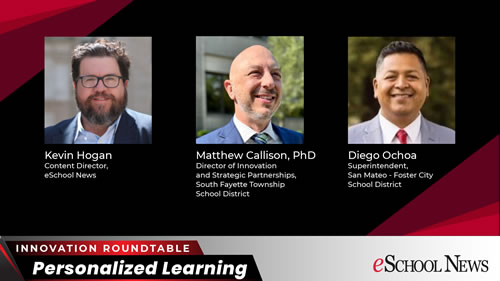Personalized learning has emerged as a pivotal strategy in educators’ quests to meet students where they are and boost engagement. Still, equitable access to technology, the right PD, and better assessment tools can make or break these instructional efforts.
During an eSchool News Innovation Roundtable with a focus on personalized learning, moderated by eSchool News Content Director Kevin Hogan, school leaders discussed their experiences with personalized learning, where they’ve found success, and what they think it will look like in the future.
Participants included:
- Dr. Matthew Callison, Director of Innovation and Strategic Partnerships, South Fayette Township School District (PA)
- Diego Ochoa, Superintendent, San Mateo-Foster City School District (CA)
Key takeaways and insights from the roundtable include:
What does personalized learning mean in the day-to-day management of a school district?
“We think about how we can provide more personalized opportunities for students in terms of course content and learning experiences,” said Callison. “I think there’s an element of that that involves technology, but really, how can we keep the human at the center while also creating more authentic and powerful learning opportunities for students that are relevant to their future.”
In fact, looking to the future is a key part of personalized learning. “At a high level, thinking about what are these opportunities that are relevant to students now and as they look to their future, and how we can create that in the district, whether that’s a new physical space or a new program, and then taking time to build out teacher capacity, build buy-in from teachers, build those relationships,” Callison said. … “That’s one of the ways we’re approaching personalized learning, just creating those more meaningful opportunities for students that traditionally haven’t been in school.”
“Personalized learning is about creating learning experiences that put the decision-making into the hands of kids, of what those students want to do, and what those students are excited to learn more about,” Ochoa said. “You’ve got to have a curricular design for it, an approach that wants technology to come into the picture without being the entire thing. And think about how the adults in your system facilitate personalized learning. It’s really about getting into that student space and asking those big questions that allow them to drive their learning in the direction they feel passionate about.”
Take every opportunity to see personalized learning in action–in your district, a new district, or a professional conference
“You have to go to these hubs where ideas are shared, because districts present at those places because we know it’s an extension that often comes back with another idea,” Ochoa said. “When you get your foot in the door, you come back with a list of things you want to follow up on.”
“You can’t unsee something, so by visiting a school or startup company and seeing how they do things, or seeing a new program in another school, [it] just opens your eyes to what’s possible,” Callison said.
“Sometimes it’s just about sharing [within your district], just giving teachers that opportunity to learn from another adult–even if it’s a peer in their own district,” Ochoa said. “We see the design of personalized learning as one thing, we see the investment of personalized learning as one thing, we see the theory of it, but there’s also a practitioner space. You have to get into that space and work with these folks to understand how they are turning it into action with the kids.”
What’s next for personalized learning?
“We’re helping students understand their strengths, interests, and career preferences,” Callison said. “We’ll continue to build out opportunities and programs that are built with intentionality, around being inclusive, and around inviting all students to participate in them. We’ll continue to explore different technological solutions that could provide that extra support we’re all looking for. I don’t think there’s any magic bullet, but there’s definitely a place for technology to plug in to provide support, both for the teachers and for the students–and even for building better communication between students, family members, and teachers.”
With help of a grant, Ochoa’s district will aim to boost personalized learning opportunities at schools that serve 80 percent or more students who are homeless, foster youth, multi-lingual learners, or low-income.
We have tremendous income inequality,” he said. “What’s on our agenda in the next five years is to seek out innovative thinking and innovative programming that’s individualized–that we can bring to these schools in particular. We want to give their kids experiences at their schools that bring all this content to them.”
See more eSN Innovation Roundtables exploring critical education issues
Related:
Agency and self-direction: Giving students a voice
3 simple strategies to supercharge student growth
For more news on personalized learning, visit eSN’s Innovative Teaching hub
- 5 can’t-miss events at ISTELive 24 - June 13, 2024
- 5 can’t-miss events at ISTELive 24 - June 11, 2024
- Despite guidance, generative AI remains a challenge for educators - June 6, 2024


